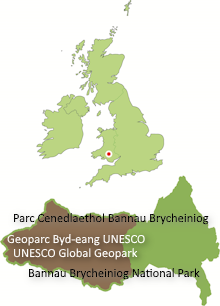(23 – 2.6 million years ago)
No rocks of this age are known to be preserved within Fforest Fawr Geopark. In common with most of Britain (but not parts of south and east England) the area lay above sea level during most of this period and is believed to have enjoyed a climate that changed from warm-temperate to cool-temperate. It is possible that thick deposits of ‘silica sand’ which are scattered around the hills of the Geopark were formed during Palaeogene/Neogene times. Originally solid rock, it has been suggested that these crumbly sands originated from the in-situ deep weathering of the Twrch Sandstone in a hot climate.
Far to the west the modern Atlantic Ocean continued to widen and far to the south the Alps were being raised. In Wales, as over much of western Britain, the rocks were lifted up perhaps as much as 1000 metres so that what remains after subsequent erosion forms the present high hills.
The Antarctic ice-sheet which developed in the late Palaeogene (about 33 million years ago) expanded during the Neogene.
The nearest exposures on land of rocks of this age are to be found in Cornwall, Kent and Suffolk.
What’s in a name?
The Neogene together with the Palaeogene period which precedes it are the new names for what we used to call the Tertiary Period.
The name ‘Neogene’ derives from the Latin for ‘new formation’ – the later part of the former Tertiary period.
‘Tertiary’ belongs to a time in the history of the science when geological time was divided into four great ‘orders’: the Primary, Secondary, Tertiary and Quaternary. We no longer use the first two terms but ‘Tertiary’ and ‘Quaternary’ are still commonly used.
Confusingly the Quaternary period (which continues to the present day) has sometimes been considered as a part of the Neogene and this is reflected in books and papers written by a few geologists.



